Top 15 Hidden Gems in Croatia
- By Seema
Croatia is a beautiful country that has earned a spot on the wish lists of most travelers. The region is famed for its wealth of history, picturesque towns, spectacular landscapes, and vibrant culture. With a coastline that stretches along the Adriatic Sea for more than 1,100 miles, Croatia’s coast is frequently considered the most beautiful in Europe. Croatia’s popular tourist attractions, such as Dubrovnik, Split, Plitvice Lakes, and Hvar, have global recognition and often steal the spotlight. The majority of visitors to Croatia—from party animals and beach lovers to cruise enthusiasts and Game of Thrones fans—visit these locations.
With over 1,000 islands strewn around the country, it’s surprising that so many people cluster in Croatia’s handful of destinations. If you look beneath the surface and go off the beaten path, Croatia is just as rewarding. The country is dotted with secluded islands, spotless beaches, quaint villages, forested interiors, and untold stories. If you’re looking to get away from Croatia’s main tourist hubs, you will find plenty of incredible hidden gems where the tourist imprint is lower, the crowds are smaller, and the vibe is more relaxed – everything needed for a unique and memorable vacation.
Here is your comprehensive guide to the top-secret spots in Croatia that you must see for yourself. You’re going to discover 15 hidden gems that may not be as well-known as the Croatian tourist haunts but are nevertheless as stunning.
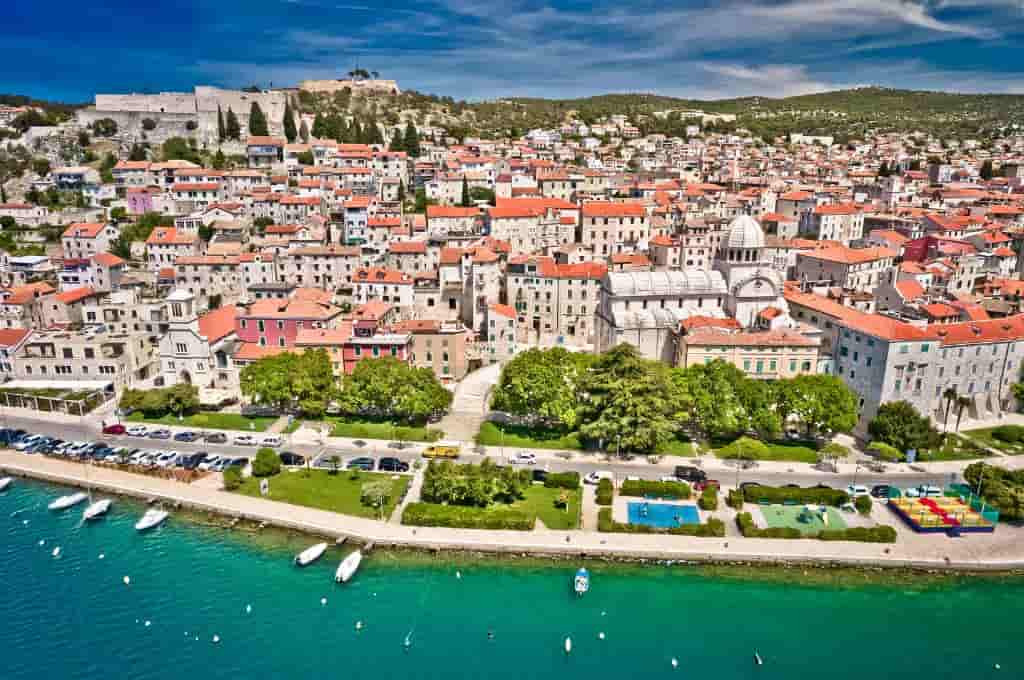
Table of Contents
1) Šibenik, Croatia
Šibenik, founded 1000 years ago, is a historic town on Croatia’s Dalmatian coast. Since it’s a great starting point for exploring the 150 nearby Croatian islands, Šibenik is often referred to as the “Gateway to the Kornati Islands.” Nestled in a sea inlet between the bustling cities of Zadar and Split, Šibenik shares many similarities with Dubrovnik. The oldest seaside town in Croatia is distinguished by its magnificent fortresses, cobblestoned streets, charming squares, stone buildings, and antique churches. The breathtaking views and towering St. Michael’s Fortress were the reason it was chosen as a filming location for Game of Thrones.
UNESCO-listed St. James Cathedral is an outstanding example of Renaissance and Gothic architecture. Šibenik, a coastal town, has a picturesque waterfront (Riva) lined with eateries and cafes, making it the ideal place to spend your evenings. Despite its recent surge in popularity, Šibenik remains free of crowds and is still fit to be tagged as one of the hidden gems of Croatia.
How to reach Šibenik?
Driving is the most convenient way of traveling to Sibenik once you’re in the country. Sibenik is only an hour’s drive from popular neighboring locations like Split and Zadar. If you do not have your own transportation, you can take the bus from Split or Zadar to Šibenik.
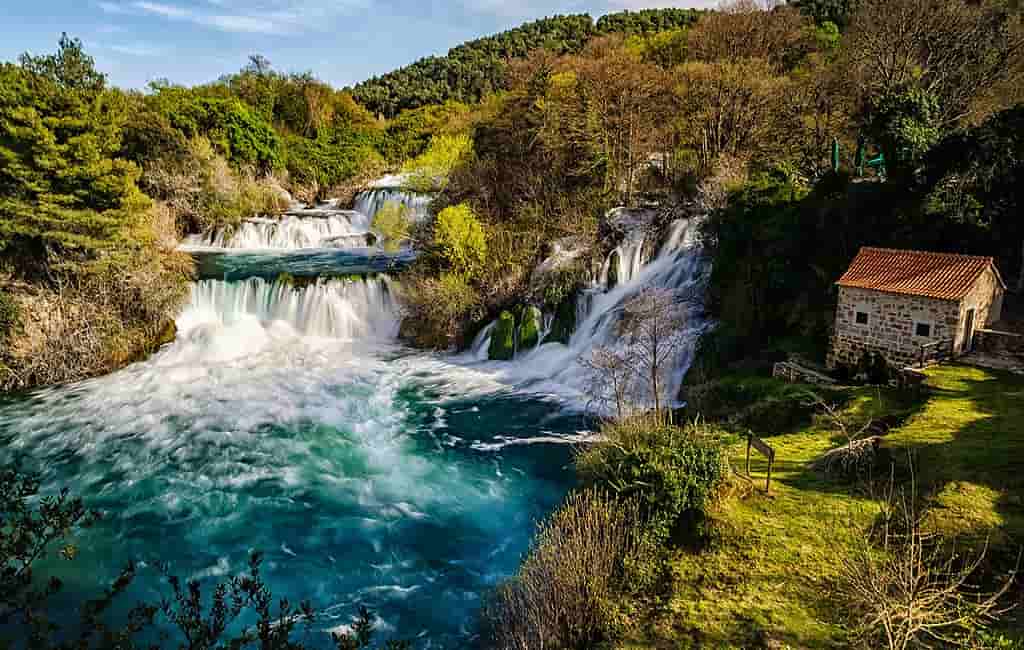
2) Krka National Park, Croatia
Krka National Park is one of Croatia’s most beautiful national parks, yet it is frequently ignored due to the popularity of the Plitvice Lakes. This delightful wonderland has a small Visovac Island, seven stunning waterfalls, fascinating gorges, old ruins, and the jade-green Krka River. Krka is mostly known for the spectacular Skradinski Buk Falls, a group of 17 waterfalls. Water from the Krka and Cikola Rivers flows into 17 travertine stairs, creating deep pools before crashing down to form the gorgeous Skradinski Buk. The spectacular grandeur of this waterfall can be experienced on an hour-long loop trek.
Explore Roški Slap, the second most popular waterfall in the park, for another remarkable experience. Twelve travertine waterfalls flow here, converging to create a staggering 49-foot plunge. Other prominent attractions in Krka include medieval fortresses and the Serbian Eastern Orthodox Monastery. Keep in mind that it might get rather crowded during the summer months.
How to reach Krka National Park?
The park is located roughly halfway between Split (86 km) and Zadar (77 km), with the closest city being Šibenik (13 km). The park has five entrances, but the majority of visitors enter through the Lozovac entrance or reach by boat from the Skradin entrance. A bus service runs from Split to the park’s Skradin entrance.

3) Vis, Croatia
If you’re hunting for a tranquil spot to soak up the Adriatic sun, don’t ignore Vis. The island is famous for its beautiful beaches, crystal-clear waters, and scenic views. Stiniva Cove, with its crystal clear waters and sheltered pebble beach, is indisputably Vis’s highlight. With a hidden lagoon nestled between two towering rock cliffs and a narrow channel leading into the azure sea, it’s like walking into a picture-perfect frame.
Due to its secluded location, Vis was used as a military base during World War II and subsequently by the Yugoslav Navy. The island was only made public in 1989. The tourist numbers have steadily increased in recent years, thanks in part to the hit film Mamma Mia 2. When you think about Mamma Mia, you most likely envision Greece. However, many of the scenes were filmed on Vis’s gorgeous shores. Despite its growing popularity, Vis has managed to retain its authenticity and charm.
How to reach Vis?
Split is the main access point for Vis. While there are periodic ferry services from other locations, the best route options are available when traveling from Split. During the summer, the Jadrolinija car ferry from Split to Vis departs many times every day and takes 2.5 hours.

4) Biševo, Croatia
Biševo is located in the heart of the Dalmatian archipelago, five km southwest of Vis. With an area of only 6 kilometers and a population of 19 people, Biševo is one of the tiniest and most distant inhabited islands in Croatia. This is the closest you can get to having an island to yourself. Despite its diminutive size, Biševo’s stunning appeal is irresistible.
The Modra Spilja, or Blue Cave, is located on the islet of Biševo and can only be accessed by boat through a small sea entrance. The sunlight reflecting off the white limestone on the sea bed creates ethereal blue hues illuminating the magical grotto. Admire this natural phenomenon as you bob over crystal-clear water. Take the remainder of the day to explore monastic ruins, visit the nearby beaches of Mezoporat, Porat, and Salbunara, and spend time with the dolphin and sea turtle colonies that live in the surrounding waters. After nightfall, marvel at the starry sky over Biševo.
How to Reach Biševo?
To reach the island of Biševo, take the ferry from Split to Vis. A year-round boat service runs from Komiza on the island of Vis to Porat on Bisevo. Boats operate daily and make three stops on Bisevo: Salbunara, Porat, and Mezuporat (for Blue Cave excursions). Alternatively, you can reach Bisevo by joining an organized excursion from Vis, Split, or Hvar
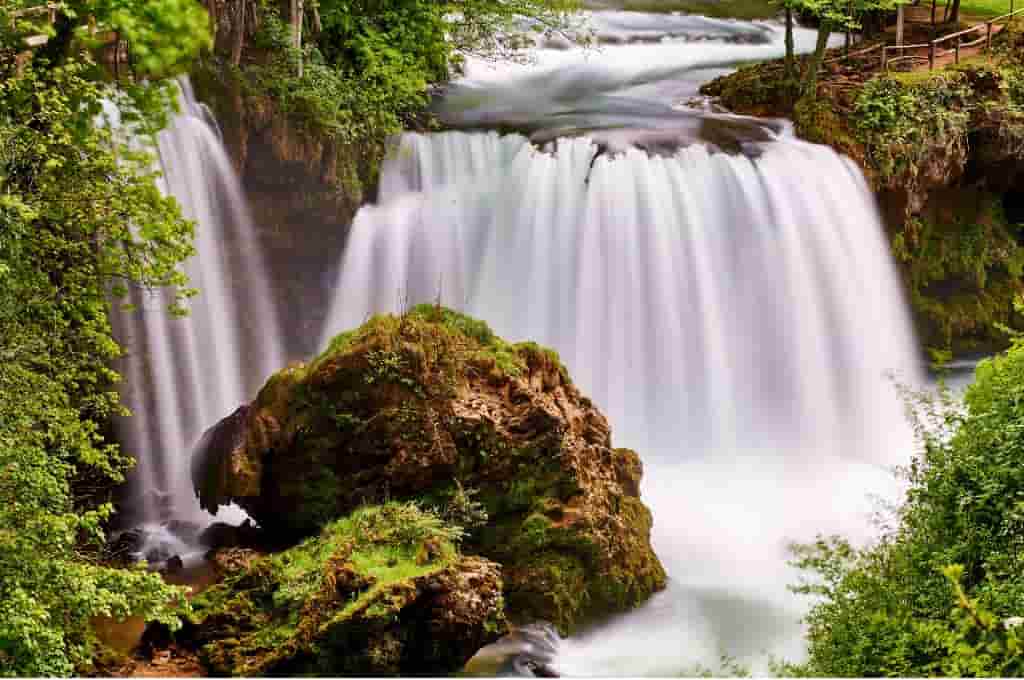
5) Rastoke, Croatia
If you’re traveling from Zagreb to Plitvice, make a stop at Rastoke for the day. Nested in the town of Slunj, the charming village of Rastoke sits on the spot where the River Slunjčica merges with the River Korana. The area is distinguished by a natural symphony of 23 waterfalls, numerous small cascades, and a charming settlement perched atop. The waterfalls are remarkable not for their size, but for the fact that they literally flow through and below the town.
Rastoke is also referred to as the “Mini Plitvice Lakes” as it shares the karst topography of rivers and gorges with the nearby Plitvice Lakes. Rastoke may not have the epic magnitude and majestic splendor of Plitvice, but this is your opportunity to experience the natural phenomenon with a fraction of the crowd. Historically, it was a perfect place to establish water-powered mills, the first of which opened in the 17th century. Along with the waterfalls and streams, Rastoke also features small islands connected by bridges, an 18th-century mill, a cave, a Winnetou totem, and a fairy garden.
How to reach Rastoke?
The simplest way to reach Rastoke is by car. The drive to Rastoke from Zagreb is about 130 kilometers and takes about two hours. Regular bus services operate from Zagreb to Slunj for those who choose not to drive. When you get to Slunj, you can either walk (30 minutes) to Rastoke or take a local cab.
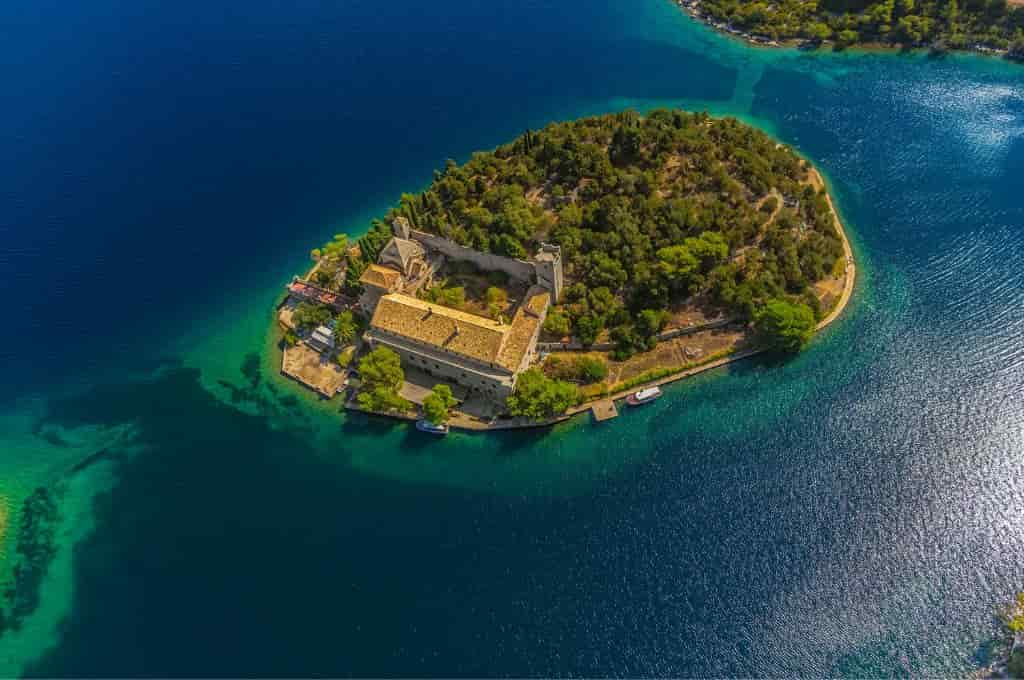
6) Mljet, Croatia
Sparsely inhabited and virtually car-free, Mljet is an Adriatic island located in the center of the Dalmatian archipelago. Mljet gets overlooked by travelers due to its location as the most southerly island. However, Croatia’s greenest island must be visited for its lush vegetation, saltwater lakes, Mljet National Park, and architecture from the 13th century.
Mljet National Park, which covers the entire northwest part of Mljet Island, is Southern Dalmatia’s most significant protected area. This verdant sanctuary is a perfect blend of dense woods, crystal-clear lakes, rare wildlife, and countless folktales. Hiking or cycling are the ideal ways to explore the national park, with plenty of opportunity to swim or kayak in the two saltwater lakes, Veliko and Malo Jezero. Those preferring peace can take a boat across the lakes to the old Benedictine monastery on St. Mary’s Island, which is located in the center of Veliko Jezero. Mljet is sought-after for its white and red wines, olives, and goat cheese.
How to reach Mljet?
Reaching Mljet Island can be a little difficult because there isn’t an airport, train station, or bus stop there. Visitors to the island should most likely arrive in Dubrovnik or Split. Travelers can use public transportation from either of these two locations to reach Praprat. Travel time from Praprat to Dubrovnik is around one-half-hour, and from Split, it takes roughly 4 hours. The next phase requires travelers to board a ferry for a short ride to the island. It takes 45 minutes to reach Sobra (Mljet) from Praprat by ferry.
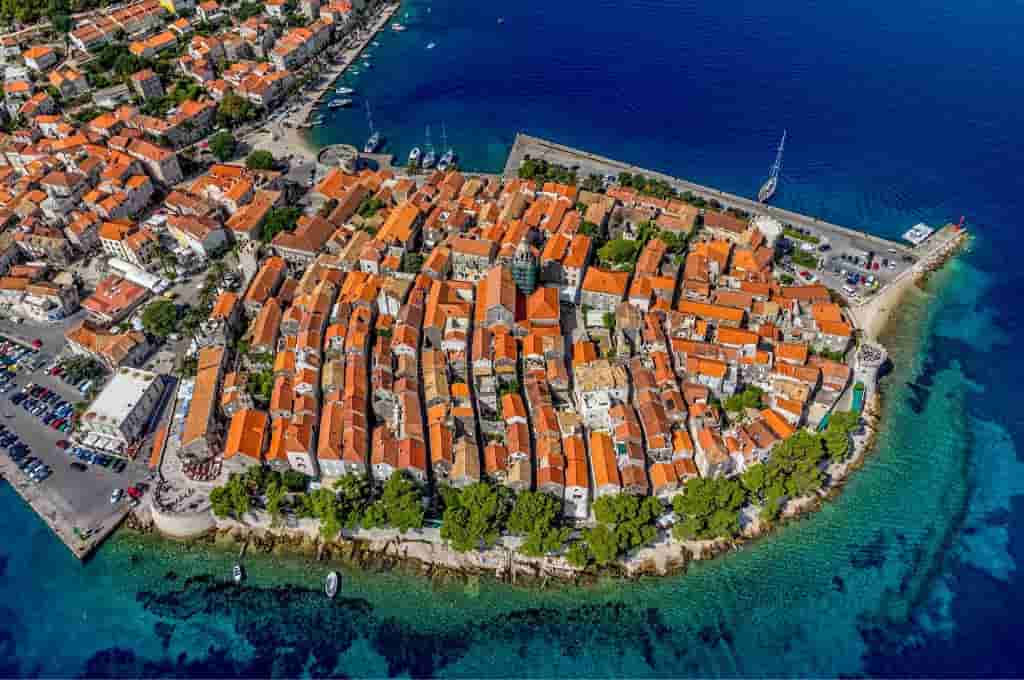
7) Korčula, Croatia
Korčula is popular, but not as busy or packed as other Croatian islands. Despite being located close to the famed Dubrovnik and Hvar, Korčula draws substantially fewer visitors. The village has rolling vineyards, hidden beaches, stunning coves, endless olive groves, and plenty of sunshine. Korčula is known as the wine island, boasting unique grape varietals like Grk and Pošip. Wine aficionados can stop by the friendly wineries of Popic, Bire, and Zure for a tasting.
The charming old town of Korčula, which is partially encircled by fortress walls, has been dubbed “Little Dubrovnik.” The town proudly claims to be the birthplace of the legendary adventurer Marco Polo. While in town, stroll through the quaint stone streets, stop by Marco Polo’s house, and visit St. Mark’s Church. The old town area offers a great cultural experience, but if you enjoy the beach, head to pebble-free beaches such as Bilin Za, Vela Przina, and Pupnatska Luka. If you plan to stay for 3-4 days, you can do several excursions, day trips, tours, and activities in Korčula
How to reach Korčula?
As the island lacks an airport, visitors must fly to Split or Dubrovnik and then use available modes of transportation to reach Korčula. Kapetan Luka, TP Line, and Jadrolinija run many ferry routes to Korčula from Split and Dubrovnik. Korčula may be reached in just under two hours from Dubrovnik, whereas it takes 2.5 hours from Split.
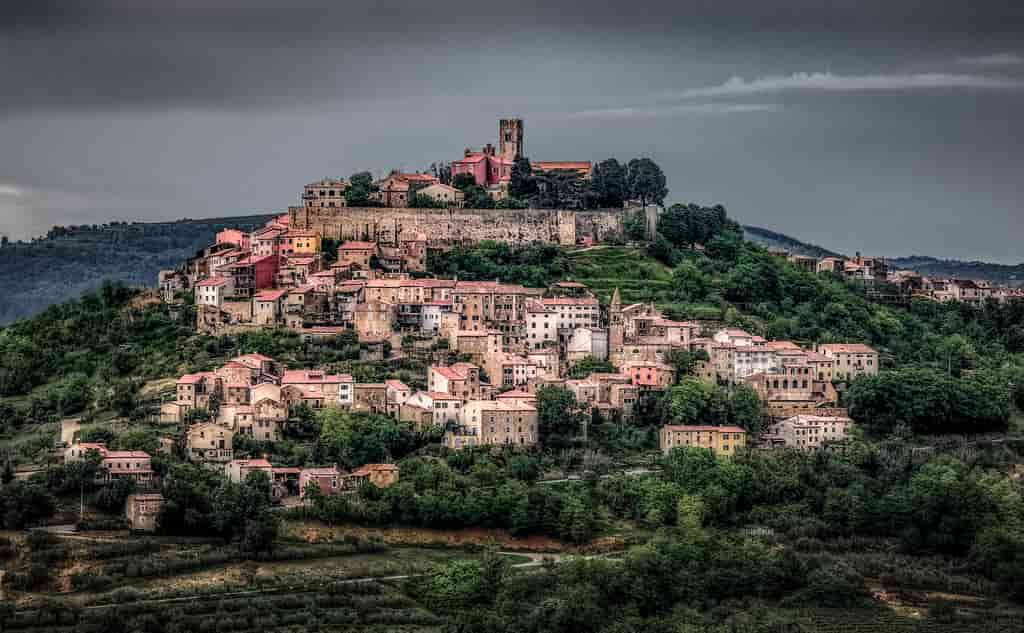
8) Motovun, Croatia
Tucked between the beautiful slopes and verdant fields of Istria lies Motovun – one of the prettiest towns in the region. The picturesque little village of about 1000 people sits atop a large hill that is primarily accessible on foot. Motovun’s history dates back to the Roman era, and its medieval stone alleys are lined with spectacular architecture and history. The 13th-century Romanesque-Gothic bell tower stands next to the Parish Church of St. Stephen from the 17th century. The Romanesque Municipal Palace, Istria’s greatest secular edifice at the time, is located in the central square and is flanked by numerous other historic buildings.
The ancient walls that encircle Motovun offer spectacular vistas of neighboring forests and endless vineyards, making it a photographer’s dream. Motovun is known for its truffle-rich forests and scenic vineyards. You will be impressed by the fine quality of its wines, olive oils, and truffles. The elegant architecture, phenomenal panoramas, and fantastic cuisine make Motovun a delightful addition to your Croatian vacation
How to reach Motovun?
Pula is the closest airport to Motovun. However, it makes more sense to travel from Zagreb, which has an international airport and much better connectivity. Motovun is within a three-hour drive from Zagreb. Buses are available to nearby places like Poreč or Buzet, but a private conveyance, such as a cab, is required for the final leg of the journey. Motovun is about 45 minutes from Rovinj, making for an easy day excursion.
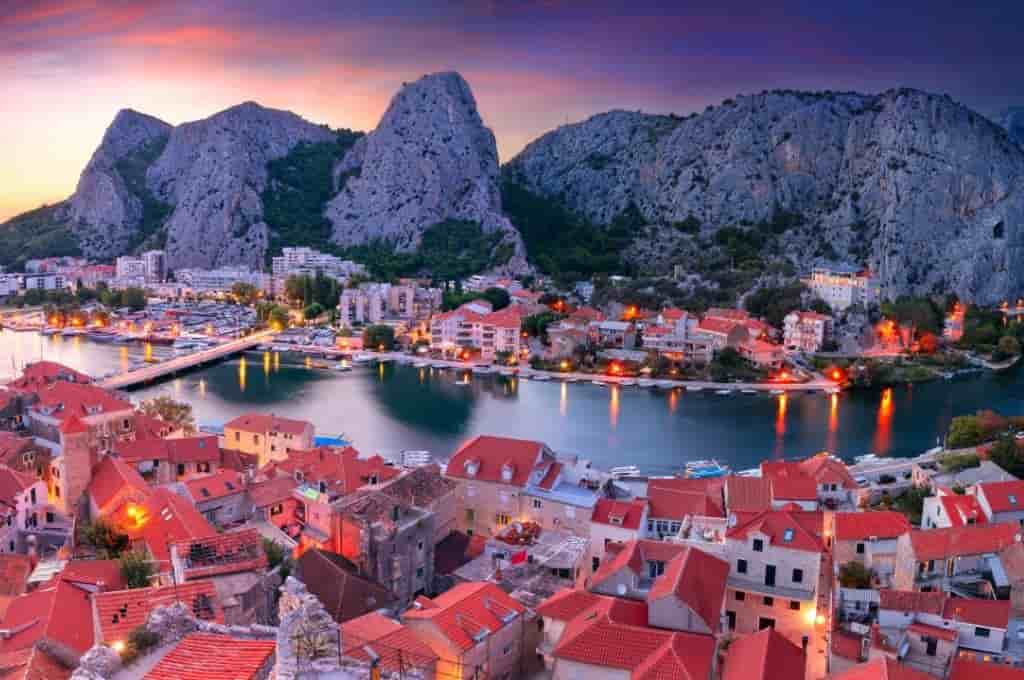
9) Omiš, Croatia
Omiš is a tiny town about 30 minutes south of Split, located where the Cetina River plunges into the Adriatic. Despite its proximity to the popular tourist destination, Omiš remains an excellent choice for an idyllic Croatian beach getaway sans crowds. Omiš used to be a favorite refuge for local pirates, but it is now one of Croatia’s secret spots. The town rests at the foot of majestic mountains and enchants visitors with an abundance of natural beauty, fabulous beaches, and amazing attractions.
Apart from the picturesque old town and the 13th-century Mirabella Fortress, Omiš’s most prominent landmarks are the majestic Starigrad fortification on the mountain and the gorgeous Centina Canyon. Climb to the rooftop of the Starigrad Fortress for jaw-dropping views of the town, the Cetina River Canyon, and the Adriatic Sea. In addition to being an attractive getaway in its own right, Omiš is a great starting point for excursions in the surrounding area, due to its location at the mouth of the Cetina River. You can do canyoning along the untamed gorges, float through the rapids, kayak along the coast, or enjoy ziplining on the longest ziplines in Croatia.
How to reach Omiš?
Omiš is located around 20 kilometers southeast of Split, in the direction of Dubrovnik, making it easily accessible. You can choose to travel there by bus, taxi, or private car.
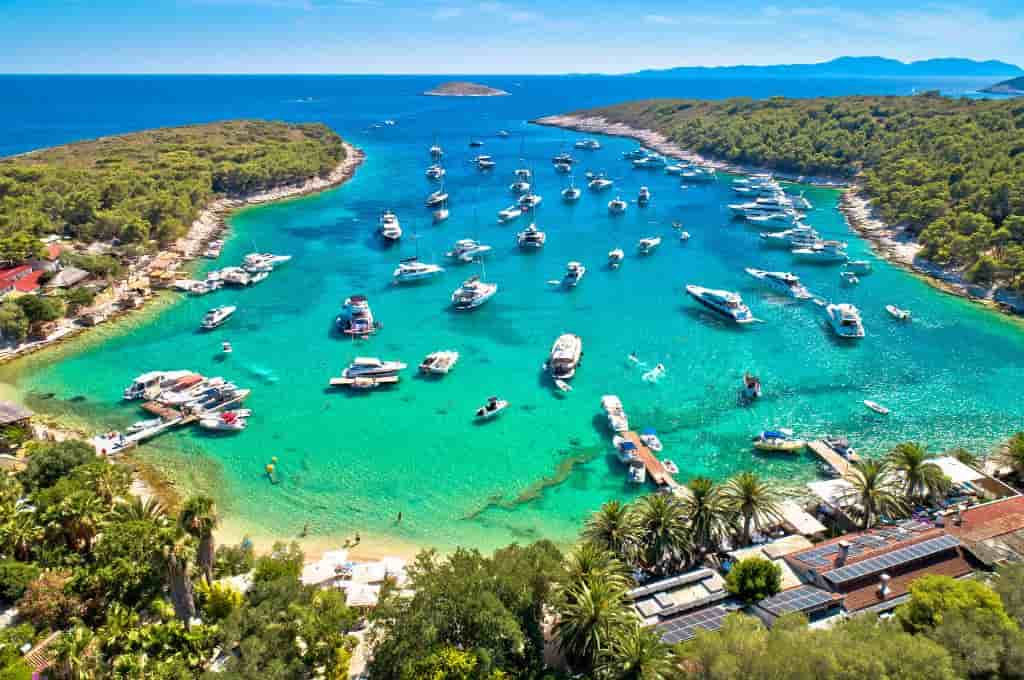
10) Palmižana, Croatia
Palmižana is one of the most prominent tourist resorts near Hvar as well as a nautical marina. It is located on the southern side of St. Klement Island – the largest of the Pakleni Islands archipelago, which stretches all the way to Hvar town. Palmižana is where Professor Eugen Meneghello decided to build his beautiful botanical gardens in 1906. He bought a 300-hectare plot of land with two pebble beaches and planted pine trees, exotic shrubs, palms, and fragrant herbs. Even after a century, his descendants continue to care for his exquisite gardens but have transformed it into a bohemian resort complete with villas, bungalows, and two restaurants.
This hidden gem in Sveti Klement is completely car-free, with secluded beaches, hidden bays, and excellent snorkeling, surfing, and diving opportunities. Palmižana beach, located in Vinogradišće Bay on the island’s southern side, is both pebbly and sandy. ACI Marina Palmižana, open from early April to late October, is one of the best marinas in the Adriatic. It lies in a cove on the north side of Palmižana and St. Klement. The resort town also has a busy nightlife, making your visit even more unforgettable.
How to Reach Palmižana?
There are no direct ferry or catamaran services to Palmižana, thus, you must travel through Hvar. To reach Palmižana from Hvar, rent a boat or take a taxi from the harbor.
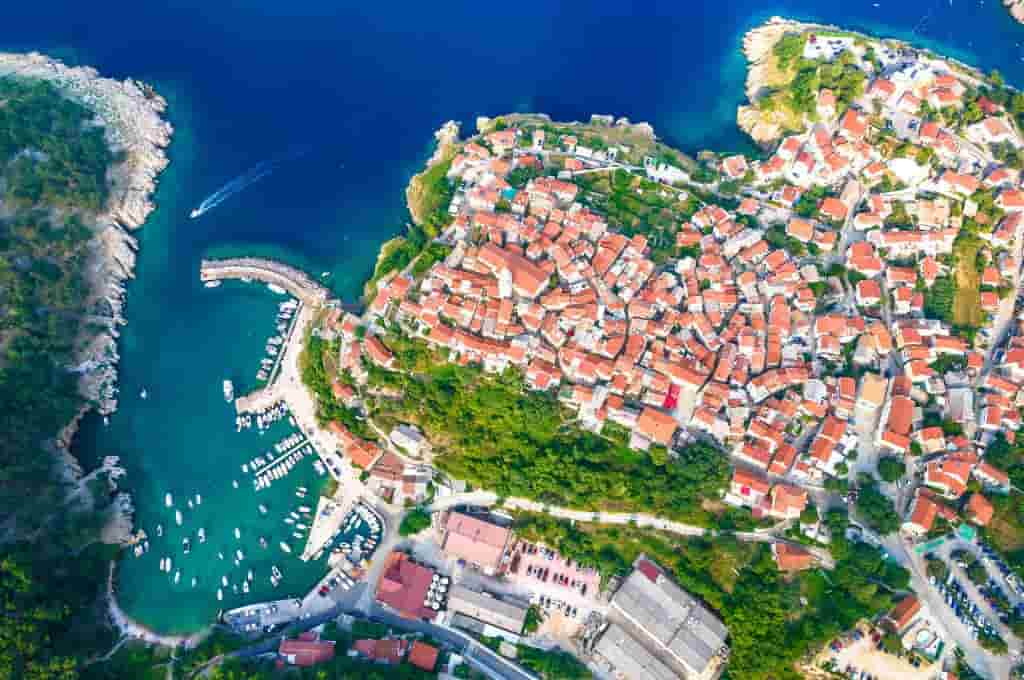
11) Vrbnik, Croatia
The village of Vrbnik, with 1,300 inhabitants, is located on the eastern side of the island of Krk in Croatia. Vrbnik is the place to go if you want to experience authentic local culture, learn about history, laze around on the beaches, appreciate the stunning landscapes, and indulge in fine gastronomy. Situated atop a 49-meter-tall cliff that plunges straight into the azure sea, Vrbnik gives the impression of rising out of the ocean. The historic Old Town of Vrbnik, stretching back over 900 years, is one of the city’s most impressive attractions. As you explore the maze of old avenues in the town center, you will come across countless monuments, ancient churches, fantastic viewpoints, and amazing delicatessen stores where you can sample regional specialties.
However, the true centerpiece of Vrbnik is the narrow alley Klancic. It is one of the world’s narrowest alleys, making it a unique thing to see on the island. The beaches surrounding the stone-built town, such as Zgribnica, Kozica, Laza Sveti Marak, and Potovsce, will enchant you with their vibrant sea colors, crystal clear water, and truly Mediterranean vibes. Let us not forget about Vrbnik Žlahtina, a high-quality dry white wine created from grapes grown specifically in the vineyards of Vrbnik.
How to reach Vrbnik?
Rijeka is the closest airport (30 minutes) to Vrbnik. Visitors can hire a car at the airport or take a taxi/bus into town. If you arrive in Zagreb, it will take you 2.5 hours to reach Vrbnik.

12) Vrsar, Croatia
Vrsar is a small resort town on the west coast of Istria, about 10 km south of Porec. This hidden gem of Croatia is known for its breathtaking sea vistas, magnificent natural resources, brilliant colors, idyllic beaches, fantastic coastline, and rich hinterland. The old town stands on a hill, overlooking the sea and the breathtaking archipelago. A short, sharp hike up the hill will lead you to several viewpoints that provide incredible views of the open sea and the archipelago of 18 islets. Don’t miss the “Viewpoint Casanova” for unparalleled panoramic views of the Adriatic Sea.
Vrsar has a beach promenade, brightly colored stone houses rising above the cobblestone streets, and numerous historical landmarks. You can explore a number of the attractions, including the Main City Gate, the Bell Tower, Vrsar Castle, St. Foska Church, St. Martin’s Church, and the Basilica of St. Mary of the Sea. Lim Channel, a 12-kilometer fjord that is actually a submerged karst canyon, is one of the area’s biggest attractions. Sculpture Park Dzamonja is located just north of town and showcases the work of renowned Yugoslav artist Dusan Dzamonja. The 18 uninhabited islets can be explored by motor boats leased in Vrsar.
How to reach Vrsar?
The best airport to fly into would be Pula Airport, which is located about 50 miles north of Vrsar. From the airport, a shuttle bus will take you to Pula’s main bus station. Alternatively, you can rent a car and drive to Vrsar.
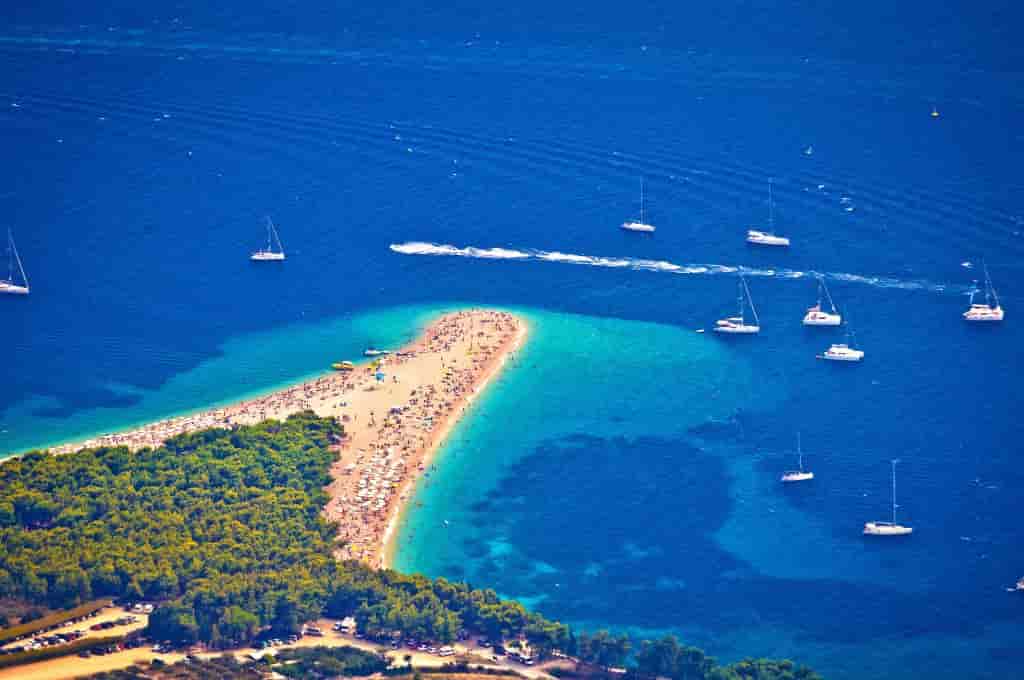
13) Brac, Croatia
The island of Brac is the longest and most elevated island in the Dalmatian region of Croatia. The laid-back island is endowed with magical bays, little beaches, lush wineries, Cyprus woods, and some pretty coastal villages. Bol and Supetar are the island’s main cities, with the former being the most popular place for travelers to stay. Brac has many beautiful trails, including routes to the top of Vidova Gora, the highest mountain on any Adriatic island. From the summit, you can see the town of Bol, the Golden Cape, and the nearby islands of Hvar and Vis.
Beach hopping is an excellent way to discover Brac’s picturesque beaches, including Zlatni Rat – the iconic Croatian cape that appears prominently on every tourism poster and flyer. This breathtaking golden strip of land, flanked by the pristine Adriatic Sea, looks postcard-worthy and is touted as Croatia’s best beach. However, it can be rather crowded during peak season, so you can visit other beaches like Martinica, Murvica, Kotlina, Acapulco, and Lovrecina. Brac is known globally for its brilliant white building stone, which has been mined since ancient Rome and utilized in the construction of buildings as far away as Europe and North America. Water sports activities are particularly popular on Brac, ranging from diving to parasailing, kitesurfing, and windsurfing.
How to reach Brac?
The quickest way to get to Brac Island is to fly to Split and then board a ferry from the Split ferry port to Supetar on Brac. The ferry port is roughly 24 kilometers from Split Airport.
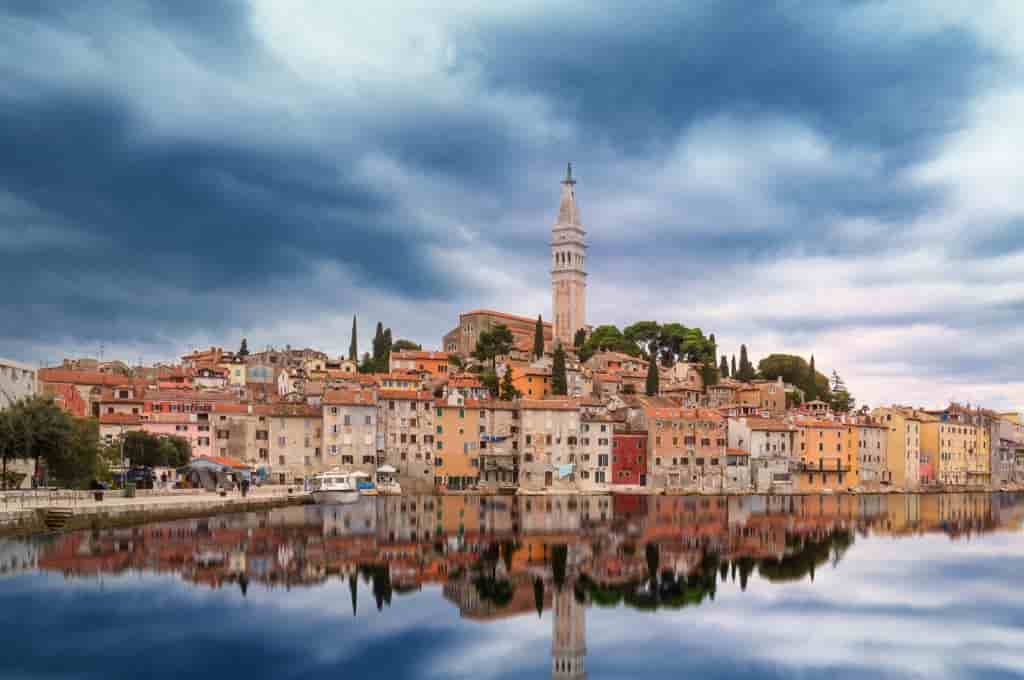
14) Rovinj, Croatia
Rovinj is a small beach town on the Istrian Peninsula, a heart-shaped peninsula that feels and looks more like Italy. It was formerly an island, but in 1763, the short canal that separated it from the mainland was filled. The fishing town has been shaped by different civilizations throughout history and was part of the Venetian Empire until the 18th century. This delightful amalgamation of multiple civilizations distinguishes Rovinj from the other cities on the Istrian Peninsula. From centuries-old churches and baroque buildings to colorful houses and a photogenic harbor, Rovinj has everything going for it. The nearby nature parks and turquoise waters of the Adriatic add to the beauty of the region.
The major attractions are in or near the Old Town. Apart from the pastel-colored homes and marble-cobblestoned alleyways, this area of Rovinj is also known for its exquisite Venetian architecture. Rovinj’s must-see attractions include the Old Town, Church of St. Euphemia, Golden Cape, and Olge Vicel’s Gallery. Rovinj is mostly known for its old-world charm and medieval architecture, but you can also unwind and swim on idyllic beaches such as Vestar, Mulini, and Lone Bay. Despite its unique beauty, Rovinj continues to be a hidden gem.
How to reach Rovinj?
Rovinj is served by Pula Airport, located just 40 kilometers away from Rovinj. The largest international airport near Rovinj is in Venice. It’s a 3-hour drive from Rovinj, but a boat ferry also connects Venice to Rovinj in the season. Rovinj is likewise a short drive from Zagreb—just 250 kilometers—and is best accessible by car.
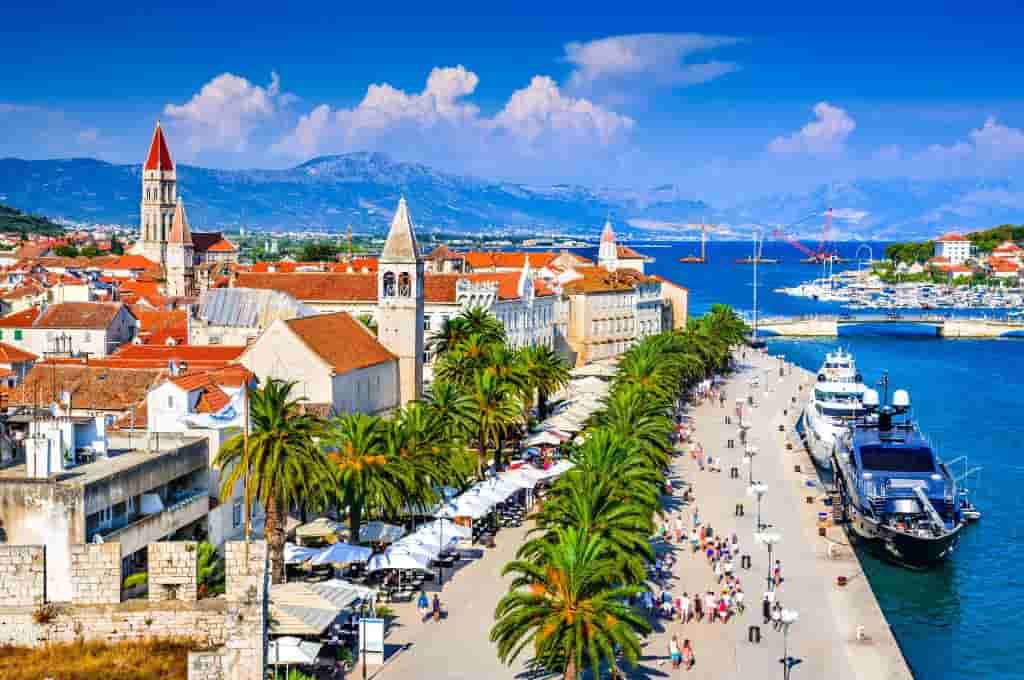
15) Trogir, Croatia
Trogir, situated just off the mainland and north of Split, is another hidden gem of Croatia that was named a UNESCO World Heritage site in 1997. National Geographic ranked Trogir as the world’s best city-island in 2015. Trogir is located on an island that is connected to the mainland via bridges. This town is really tiny, and you can walk from one end to the other in about 7-8 minutes. As you stroll through the old city streets, you’ll stumble upon Gothic houses, little palaces, historic churches, and many other well-preserved Renaissance and Baroque structures from the Venetian period.
The focal point is the Cathedral of St Lawrence, located in the heart of this Romanesque town. It was built in the 13th century and continues to stand today. The Chapel of St. John is a must-see within the cathedral and is regarded as the best Renaissance sight in Dalmatia. Other sights to visit include Kamerlengo Castle, St Sebastian’s Church, Cipiko Palace, Derossi Palace, Town Museum, and Town Gate. One of the most picturesque areas of the city is Riva – the seaside promenade lined with cafes, pubs, and ice cream parlors. The beach lovers can head to Okrug Gornji and Medena Beach
How to reach Trogir?
Trogir is just 27 kilometers from Split, making it the perfect day trip destination. Driving from Split to Trogir is the quickest method to get there. Alternatively, you may travel to Trogir by bus or taxi. Joining a guided tour is another way to visit Trogir.
